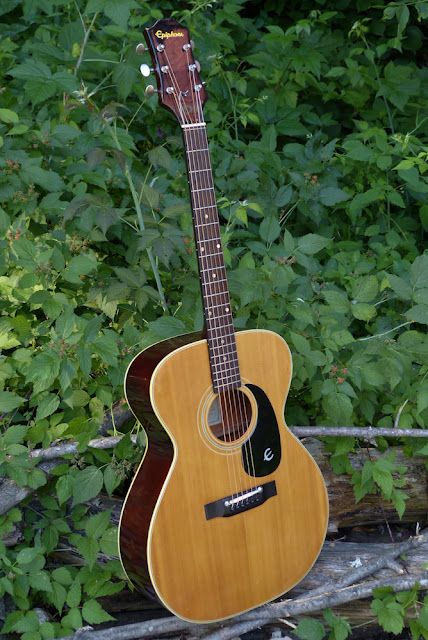1970s Epiphone FT-130 Caballero 000-Size Guitar
A friend of mine picked this up on a cross-country road journey and brought it in for service. This is one of the cleaner '70s Epi acoustics I've had the chance to work on (most are thoroughly played-in) and, despite being an all-laminate Norlin-era product, it's actually a pretty decent instrument. Its serial number places it in the late '70s ('76-'79)and these were apparently made in the Matsumoku (Aria) factory in Japan.
I only gave it a setup, extra saddle compensation/fitting, and a light cleaning, though it could use some fretwork up the neck from the 14th fret and on as it gets a bit of fret-chatter in there (something the owner will almost certainly not even notice as he doesn't play up the neck). The bolt-on neck construction has yielded the frustrating ever-so-slight "neck hump" after the joining fret -- something my own Fender Redondo and many old bolt-ons also deal with. Why? That's the point where all the tension is leveraged.
The "look" of the guitar is clearly a rip on a Martin 000-18, though the wood is all laminate -- spruce over mahogany. The interesting bit is that Matsumoku kept the 24 3/4" Gibson scale length when it conjured-up its zero-fret, bolted neck for this model.
Tone-wise, this sounds fine flatpicked or fingerpicked, but won't win any contests with a "real deal" 000-18 or similar. Compared to even similar solid-topped Japanese variants (Takamines, for instance) of the same vintage, this guitar will sound thinner and more mid-range in character. It's still fun, though, for all that.
The truss rod was installed nicely (not sunk too far into the neck and buried under the 1st fret like some Japanese guitars from the time) and works well. This has a 1 11/16" nut width, 14" radius, and "modern-feeling" C-shaped neck. It's fast.
The board and bridge both seem to be stained maple and the board is bound.
Despite the tiny bit of "neck hump" after the join with the body, a bolt-on neck is really handy when you have to set your action. All I needed to do was shim it up to get some good back-angle.
The bridge has an adjustable saddle, though it's of the usual import style where a softer plastic saddle is inserted into a metal base. The actual Gibson-style pin-bridge adjustable units used ebony or rosewood in a configuration that roughly matched an archtop guitar's adjustable layout and thus didn't dampen the guitar as much (the caveat here is that the ceramic saddles were just awful).
I mention all this because I'm actually a fan of well-done adjustable saddles -- they make life for the average player much easier. I had to recut and compensate the saddle insert, however, as it wasn't set for the B-string or low E/A strings at all and the radius did not match the board.
A bit of lube and the tuners were ready to go...
The factory, wisely, hid those neck bolts under a cover.













Comments
I hate to break it to you but you'll need to get a blank and fit it to match your needs. I never deal with pre-fit saddles for the most part as they never really work in the real world save with stuff like Taylors or the like.
Thanks for responding. I fully expect to be sanding away at whatever saddle insert I get. From the looks of it, and from more research, your guess at the radius is probably right on the money. It's very slight.
I've had this guitar since my college days, so getting it to a playing shape again will be a joy. I've also had to get one of the machine heads replaced. It's a work of love.
Played only a few lessons, life for young mom got busy, stored in case in closet, and 50 years later I'm trying to find out more about it. Did you discover any new info after your post?
My big disappointment was when I bought a sound-hole pick-up - and it would not fit. The sound hole on FT-133 is only 3.5" or so diameter. Most good pickups required at least a 3-5/8" diameter. Luckily I had another acoustic guitar on which I can use the pickup.